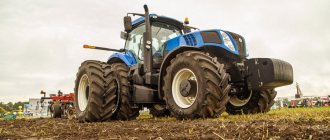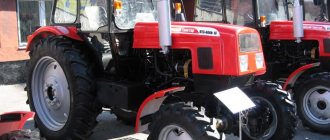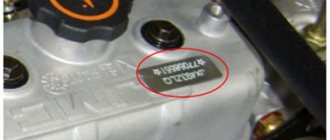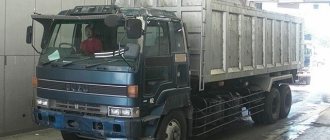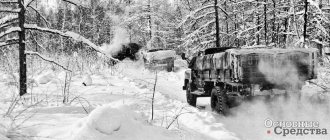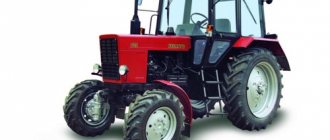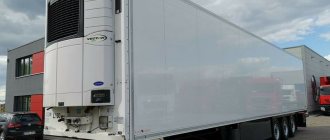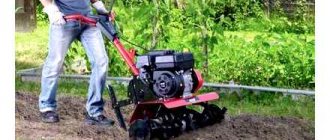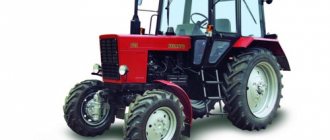Characteristics
The engine is quite high-torque and runs on heavy fuel. Its working volume is 7.8 liters, which allows you to develop crazy power, up to 300 hp. With. For more information about the technical characteristics of 6hk1, see the table.
| Engine capacity in liters | 7,8 |
| engine's type | in-line turbocharged six SOHC type |
| What does he drive? | diesel |
| What power does it develop, l. With. | up to 300 |
| KM, Nm at 1450 rpm | 761 |
| Injector type | Common Rail |
| Emission standards | Euro 2 or 4 |
| How much oil does it hold, l | 28-38 |
| Cylinder diameter (mm) | 115 |
| Piston stroke (mm) | 125 |
| Number of cylinders/valves | 6/24 |
| Compression ratio, units | 17,5 |
| Material of manufacture | cast iron |
Decoding of factory alphanumeric designations
The digital designation is deciphered as follows. The letter F means a chassis for a superstructure, and if there is a G at the beginning of the marking, then this is a Forward truck tractor. The second letter indicates the gross weight range: R - from 9 to 11 tons, S - from 11 to 13 tons, T - from 13 to 15 tons and V - over 15 tons. The third letter means the wheel formula: R – 4×2, M – 6×2, S – 4×4, Z – 6×4. The two numbers in the fourth and fifth positions indicate the engine that is installed on this truck. Namely: 90 (or 75) are 4-cylinder diesel engines of the 4HK1 series, and the number 34 corresponds to 6-cylinder 6HK1 engines.
Previous generation Isuzu Forward.
Further, the letter S denotes a chassis with dependent (beam) suspension of all wheels and pneumatic-hydraulic brakes. If there is a U there, it means the braking system is completely pneumatic. And in the last position of the alphanumeric designation there is an indication of the location of the steering wheel, which also determines the sales market: L – steering wheel on the left (as in the vast majority of countries, including Russia), or U – steering wheel on the right (for Japan, Great Britain, Australia, Cyprus and several more countries with left-hand traffic). For example, the FSR90SL model sold on the domestic market means: a left-hand drive chassis truck with a gross weight of 11 to 13 tons, with a 4-cylinder engine and pneumatic-hydraulic brakes. At the end of the marking, separated by a hyphen, there may also be letters and numbers indicating a specific modification and configuration. Namely, the length of the wheelbase, the type of cabin and other details.
For Isuzu Forward cars produced directly in Japan, the VIN number begins with the letter “JAL”; for trucks assembled in Ulyanovsk - with “Z7X”
pros
Let's first consider the advantages of this power unit:
- produced by the famous Isuzu, which is a pioneer of diesel engines - since 1952, this Japanese company has produced over 20 million engines, and not a single one has been recalled;
- super power - up to 300 horses, which makes it ideal for installation on large equipment, trucks, pickups;
- reliability - capable of traveling up to 1 million kilometers, subject to proper care and maintenance;
- maintainability - for example, the ability to bore the cylinder block to different sizes, replace bushings/pistons, etc.;
- Common Rail injection - which makes it more environmentally friendly and economical compared to other diesel engines.
Place of the model in the Isuzu truck line and in the Russian market
This is already the sixth generation of the Isuzu Forward model: the first trucks under this name were released in 1970. In addition to Japan and Russia, they are produced in a dozen other countries around the world, mainly in the mode of large-scale SKD assembly of vehicle kits (Semi knocked down - semi-disassembled).
Isuzu F series vehicles include trucks with a gross weight of 9–26 tons, wheel configurations 4x2, 4x4, 6x2 and 6x4. In the Isuzu truck line, the Forward family occupies an intermediate position between the lighter Isuzu Elf and the heavier Isuzu Giga.
Medium- and large-tonnage Isuzu Forward trucks are familiar to domestic carriers, not for the first year, and not for the first generation. More on right-hand drive used cars from Japan. These are vans and flatbed trucks with cable cranes. Of the Isuzu Forwards presented in Russia, approximately 70% are on the FVR34 model chassis with a gross weight of 18 tons, and the remaining 30% are 12-ton FSR90. Although, given the bans in recent years regarding trucks with a gross weight of over 12 tons, one could expect the opposite proportion. Apparently, the ability to enter the Moscow Ring Road and inside the capital during the day is still less important for carriers than the ability to deliver 4 tons more cargo per flight.
Minuses
As for the disadvantages:
- sensitivity to fuel - direct injection works at a disadvantage here, since it does not tolerate bad diesel fuel (very important for the Russian Federation);
- sensitivity to the quality of oil - if you fill in the wrong oil, it is possible that the crankshaft and camshaft liners may rotate;
- the need to regularly adjust the valves;
- weak timing - gear bushings often “fly”.
In addition to all this, over time it is possible that scuffing will appear on the surfaces of the cylinders, which can be solved by boring and liners.
Cabin
The truck is equipped with a comfortable folding cab with a huge glass area, wide door openings, large optics and a practical design. The cabin has three seats. The middle chair can easily be transformed into a table, plus one sleeping place with a width of 650 mm. The interior decoration is extremely simple, concise and practical. The ergonomics of the driver’s workplace are well-calibrated, thought out to the smallest detail. The driver's seat and steering column are equipped with a wide range of adjustments; The driver's seat is equipped with air suspension.
Owner reviews
There are a lot of reviews about this engine.
“Fuel consumption depends more on driving style. You can burn twice as much fuel as the others. A lot depends on the year of manufacture and the condition of the fuel injection pump 6hk1. For example, my loaded car consumes 18-19 liters on the highway, and an empty one - 16-17 liters. However, there has never been more than 20 liters.”
“He’s a real hard worker. I have owned it for 5 years, I got it in poor condition. He carried out a major overhaul almost immediately.”
“Until now, the engine has not failed, but it all started with a bad factory. After that, it began to work terribly - tripling, shooting, instability in general. I tried to drive it, but in the second it barely pulls, and practically doesn’t hold idle. The revolutions drop to 1000. I’m thinking about spark plug wires, air leaks into the common rail or 6hk1 injectors.”
Execution options
Isuzu Forward 12.0 (with a gross weight of 12 tons) is available with various wheelbase options: 4.36 m, 4.86 m, 5.15 m. Accordingly, the overall length of the truck can be: 7.255 m, 8.155 m, or 8.605 m. The width and height of the short wheelbase version are 2.24 m and 2.53 m. The width and height of the medium and long wheelbase versions increase to 2.245 m and 2585 m. The minimum ground clearance is 185 mm. The standard load capacity of the Forward 12.0 chassis, depending on the wheelbase, is in the range of 8.155 - 8.175 tons. At the same time, if a heavier Euro-5 engine is installed, the official load capacity “according to the passport” is reduced to 7.865 tons - 7.94 t. The total weight of the truck in any version does not exceed twelve tons.
Isuzu Forward 18.0 (with a gross weight of 18 tons) is available with wheelbase lengths: 5.55 m, 6.05 m; overall length of the truck is 8.2 m, 9.255 m, 10.005 m. Width – 2.475 m, height – 2.87 m. Standard load capacity – from 12.3 t to 12.5 t.
Refrigerator on Isuzu Forward chassis.
Isuzu Forward trucks are produced as a universal chassis, which allows for independent installation of all kinds of vans, bodies and special superstructures. But according to the agreements of the Japanese company with manufacturers of special superstructures, Forward trucks are equipped with pre-installed superstructures: a flatbed platform, a manufactured goods van, an insulated van, a tow truck or a flatbed platform with a manipulator, and are supplied to dealers “ready-made”.
The standard equipment of the Isuzu Forward includes: fog lights; 2 airbags; air conditioner. Additional options include a multimedia system, climate control, cruise control, leather steering wheel, driver's seat with ventilation system, heated windows and rear-view mirrors, tachometer, and exhaust brake.
The chassis of both F-series models presented in our country (Forward 12.0 and 18.0) are structurally different from each other. The 12-ton truck with a standard load capacity of 8.1 tons has a frame with side members of 225x60 mm and a wall thickness of 6 mm. The 18-tonne spars are much stronger: their cross-section is 258x85 mm, and the rolled thickness is already 10 mm. The wheels on 12-ton Forward trucks are 19.5 inches, and on 18-ton trucks they are 22.5 inches. There are also differences in wheel fastening: the FSR90 Euro-4 class is equipped with conical nuts, and the rear inner discs are pulled to the hubs by foot pads. On the starboard side the threads of the studs, nuts and fittings are right-handed, and on the left side the threads are left-handed. Which is not very inspiring to change the inner wheel on the side of the highway. On the Euro 5 FSR90 and all FVR34 versions, the discs are centered along the grooves on the hubs and secured with ISO flange nuts.
New Isuzu Forward from CMU.
There is nothing extraordinary in the suspension: both versions have springs installed in a circle. Only on Forwards from the motley fleet of used right-hand drive trucks can you often see a drive axle suspended on air springs. The fundamental difference between the Forward trucks and the “younger brothers” Elf, the N series, is the presence of a cab with a berth. Comfort on the 65 cm wide sleeping bunk, as well as in the cabin itself as a whole, is less than in European trucks, but still enough for a good rest. Moreover, the width of the Forward cabin is superior to the “elf” ones: from door to door of a 12-ton truck is 1.9 m; 18 ton - 2.10 m.
Engine cost
The price of the 6hk1 internal combustion engine depends on its configuration:
- assembled (short block) - $4600-5700;
- without attachments - $4,000.
Also, certain parts of the engine are in great demand:
- cylinder block assembly from Isuzu - 440 thousand rubles;
- block 6hk1 assembled from OEM - 360 thousand rubles;
- naked BC Isuzu - $3300;
- bare BC OEM - $2200;
- original crankshaft - $1550;
- oil pump - $210;
- sealing gaskets (set) - $400;
- connecting rod - $190;
- sleeve - $85;
- piston - $75.
You can also purchase various spare parts for 6hk1 on the websites: starter, turbine, thermostat. They will help restore the old engine and carry out high-quality overhauls.
As you can see, the cost is very high, so it is much more rational to immediately purchase a contract Isuzu 6hk1 engine. If you are not satisfied with the online price, you can also look for an alternative at a dealership.
Isuzu Forward transmission. Brake system
The gearboxes on both variations of the Forward for the Russian market are also different: the 12-ton truck has a simple 6-speed manual transmission model MZW6P, produced by Isuzu. For an 18-ton truck, the Japanese use ZF 9S1110 gearboxes - 9-speed mechanical units with a planetary range and an additional “turtle” gear.
There is a significant difference in the design of the brake drive of the two Isuzu Forward models. On the FVR34, the scheme is usual: a compressor on the engine, an air preparation unit and receivers on the frame, pneumatic chambers driving wheel drum mechanisms with a wedge-type release of the shoes. The 12-ton FSR90 is distinguished by pneumatic-hydraulic brake drive. Drum brake pads open the pistons of the working hydraulic cylinders - just like on passenger cars and light duty vehicles. Each of the two hydraulic circuits responsible for the operation of the front and rear brakes has its own pneumatic booster, structurally combined with the main brake cylinder.
Isuzu Forward gearbox.
Most of the drive components, including the water-oil separator and brake fluid reservoir, are grouped in a block on the right frame side member. A pneumatic crane is installed in the front part of the cabin, controlled by the brake pedal. Air from the receivers enters through the pneumatic valve into the pneumatic amplifiers and creates pressure in the hydraulic circuits of the operating brake mechanisms. Isuzu engineers partially modernized this design from the middle of the last century, abandoning the transmission parking brake and introducing, in parallel with pneumohydraulics, a purely pneumatic drive for releasing the handbrake. Pneumatic chambers with spring energy accumulators for each of the wheels are installed on the drive axle beam. Their pistons retract the wedge expansion mechanism rods when pressure is applied from the parking brake valve. On all trucks, the braking system is complemented by ABS.
We will go and rush...
Turning the key, you immediately hear the engine purring briskly. The cabin is not very noisy. We take off easily, the car responds well to any “swaying” of the steering wheel and immediately “goes” in the right direction. After a few minutes we test the maneuverability when turning. Quite an A - they fit in. It is difficult to evaluate the chassis suspension, since we are driving without a load, and, in principle, without a body. But driving the car is pleasant in all respects; you don’t need to strain yourself or fuss while changing gears.
The car also brakes pleasantly and smoothly, without jerking or sudden jolts. Someone spoke negatively about this model in terms of gear shifting, saying that the gearbox is unclear. Perhaps such problems arise with the original box, but we didn’t have them, because... costs ZF. By the way, Isuzu said that the car not only performs well, but also saves fuel. In addition, the car warranty has been increased - 20 thousand km or a year of mileage. Feel free, though.
Isuzu FVR34 chassis - rear view
